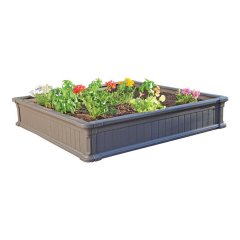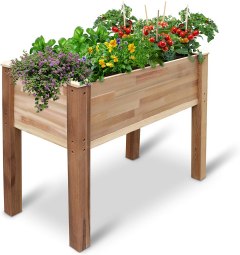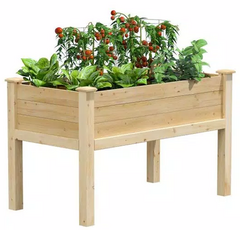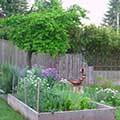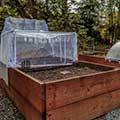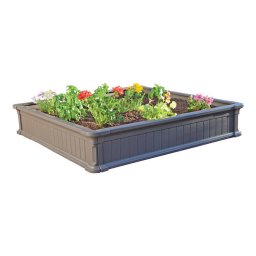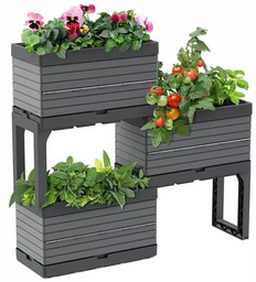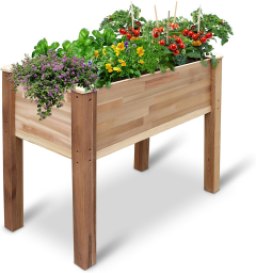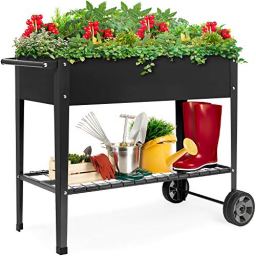Buying guide for best raised garden beds
Getting started with gardening doesn’t have to be back-breaking work. You don’t need to live in an area with loamy, fertile soil either. With a raised garden bed, there’s no digging, tilling, or struggling required.
If you live in a locale with poor-quality soil, simply fill the bed with a good soil mix, and you’re ready to go. Perfect for any gardener, raised beds are easier to maintain and require less manual labor to set up than in-ground gardens. They’re also well-suited for wheelchair users and elderly individuals who may not be able to bend over comfortably or stand for long periods. Raised gardens are also a fun project for kids.
With a little planning, you can transform your backyard, front lawn, or balcony into an appealing gardening space full of edibles and flowers. But first, you’ll need to find the right raised garden bed for your needs.
Key considerations
Your gardening vision
Avoid buying raised garden beds on a whim. First, consider what you want out of your garden. Are you interested in planting flowers, or are you keen on planting an array of tasty vegetables? Do you want to transform your entire lawn space into an edible landscape? Think about the final layout and arrangement of your beds. Do you need to invest in materials for a path?
There’s no shame in starting small, but have a vision in mind so that when you decide to expand later on, you’re not left with a hodgepodge of mismatched garden accents and accessories.
Space available
It’s so tempting to eyeball an area and assume a bed will fit. Don’t do it, though. Measure your intended gardening space, so there’s enough room for the raised bed and for you to walk around. Quick planning tip: lay out masking tape to better visualize your future garden area.
Location
You can’t just plop a raised bed anywhere on your property. Most plants require at least six hours of sunlight to thrive. Think you’ve found the perfect spot? Spend a day tracking the sunlight in that area to be sure it’s perfect for a raised bed. But don’t place your raised bed too far from your home; you’re less likely to travel out on a rainy day to check on your crops or harvest goodies for dinner.
Height
A tall raised garden bed is an excellent option for anyone with back issues. The only downside is that you’ll need a lot more soil to fill it in. If you have plenty of fall leaves each year, use them to add volume to the bed before filling it in with dirt. For wheelchair users, a tall table-style raised bed provides an accessible gardening space.
Assembly required
Are you comfortable lugging out your toolbox, or do you prefer when items are pre-assembled? Not all raised beds are quick to assemble, and some may require the use of a few tools. Often, raised beds are packaged flat for easy shipping, but pieces click together easily out of the box.
Expert Tip
Are you comfortable lugging out your toolbox, or do you prefer when items are pre-assembled? Not all raised beds are quick to assemble, and some may require the use of a few tools. Often, raised beds are packaged flat for easy shipping, but pieces click together easily out of the box.
STAFF
BestReviews
Features
Materials
Regardless of where you live, a raised bed must be sturdy in order to stand the test of time. Your garden box will be exposed all year round to the elements, from harsh sunlight to heavy rain. Here are a few raised bed materials to consider:
- Plastic: It won’t rot, but many plastic beds are made of thin plastic, which is prone to bending under pressure. After a heavy rainfall, poor-quality plastic may bow and crack. If you opt for a plastic bed, pick a model with thick walls.
- Wood: Cedar and redwood are optimal choices, since they are naturally rot-resistant. Opt for wooden beds with food-safe weather-resistant coatings for added durability. Untreated wood is fine, but it will need to be replaced or reinforced a few years down the line.
- Fabric: Fabric is a cheap, low-maintenance option. Fabric beds are great for renters or indecisive gardeners who aren’t yet willing to commit to finalizing their garden layout.
- Metal: Metal is an incredibly durable raised bed material. Garden beds made of corrugated steel offer a unique industrial look in the garden.
Accessories
A few raised beds include accessories, such as pest covers, cold-frames, digging implements, plant markers, and trellises. Raised beds that include these types of accessories, however, are often way overpriced.
" The Square Foot Gardening Foundation recommends using Mel’s Mix for raised garden beds. The mix includes equal parts peat moss, vermiculite, and compost. "
STAFF
BestReviews
Self-watering
This feature is typically only available in smaller table-style raised beds. Self-watering takes the guesswork out of caring for your plants. New gardeners often have trouble discerning when to water. First-time plant parents tend to over-water their plants thinking that more is better. Another reason to consider this type of raised bed? If you often take a vacation in the middle of the gardening season, self-watering containers often hold enough water to last plants at least a week.
Wheels
If sunlight seems to jump around your gardening space, wheels easily allow you to provide your plants with plenty of sun exposure. Wheeled units are also perfect for small areas like patios. Move them out of the way when guests arrive for a BBQ.
Stackable
The ability to add-on allows users to expand their gardening efforts year after year or to add height for greater accessibility.
Expert Tip
Encountering pest issues? Consider investing in plant coverings to prevent infestations. Insect row covers are an inexpensive option and can be reused year after year.
STAFF
BestReviews
Raised garden bed prices
Pre-assembled garden boxes are pricier than those that require assembly. Wooden raised beds are the most expensive. Find plastic and fabric boxes for well under $100 but expect to pay at least $100 for a wooden raised bed. Wooden tabletop beds, wheeled units, and boxes with accessories, such as trellises and pest covers, will likely cost over $200.
Tips
- Choose quality soil. Don’t just fill your raised beds with plain old dirt. Choose a quality soil mix or create your own. Soil should allow for air circulation, moisture retention, and provide essential nutrients.
- Mulch to retain moisture. Certain amendments help the soil retain moisture (e.g., perlite, vermiculite), but adding mulch around your plants helps prevent topsoil from drying out completely in the hot sun. Use straw, wood chips, or leaves.
- Keep size in mind. You should be able to reach into the center of your raised bed without struggling. Avoid buying a super-wide box that requires you to step onto your raised bed. Also, think about size if you plan to place your bed against a wall or fence. You may have trouble reaching plants if you put a 4-foot-by-4-foot bed against a structure.
- Plant what you eat. Not sure which vegetables to start with? Think about what most often finds itself on your dinner plate and go from there.
- Add color. Don’t forget flowers! Adding blooms to your garden not only enhances its beauty, but flowers also attract pollinators.
- Don’t be discouraged by limited space. There’s definitely a raised bed out there to fit your needs. If you only have room for a single bed, think upward instead of outward. Purchase a trellis and try your hand at vertical gardening.
Other products we considered
The Yaheetech 3-Tier Wooden Raised Garden Bed is a unique choice for adding visual interest to your garden space. The tiered structure makes it an ideal bed for planting sprawling fruit, such as strawberries. The Giantex Raised Garden Bed is a compact tabletop-style box made of rot-resistant cedar. Your back will thank you since the waist-high bed eliminates the need for bending. The stylish basket-weave finish of the Keter Elevated Garden Bed looks great sitting on a patio or balcony. We love the self-watering design and handy rain gauge, both of which cut the chances of leaving plants thirsty. On the flip side, a controlled drainage system prevents overwatering. The Vita Gardens Bed is a great starter option for new gardeners. The walls click into place without the need for tools, and there’s a handy grid to help perfectly space out your plants.
FAQ
Q. How can I prevent weeds from infiltrating my raised bed?
A. The good news is that a raised bed filled with brand-new soil won’t have many weeds to begin with. To prevent the weeds in your yard or lawn from growing upward and invading your bed, choose a raised bed with a solid bottom or place a barrier at the bottom of the bed, like cardboard or plastic mulch.
Q. Is it possible for a wheelchair user to garden?
A. Absolutely. Choose a tabletop-style gardening bed and check that the height allows for comfortable gardening in a seated position.
Q. Squirrels and other small mammals are still able to reach my garden plants and are enjoying the buffet. What can I do to deter them?
A. Consider a pest cover to prevent animals from picking through your produce. Fabric covers or netting may help deter hungry rabbits and squirrels and will keep insect pests from munching on your greens.


